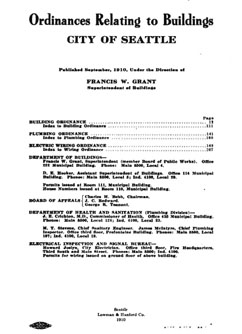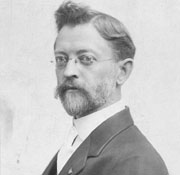Little is know about formal training and background of architect Francis W. Grant. Born on April 28, 1867 in Ontario, Canada, Grant migrated with his parents to the U.S. at an early age and became a naturalized citizen in 1875. His youth was spent in Rochester, where he received a common school education, supplemented by extensive tutoring in Engineering. He also spent some time engaged in contracting and manufacturing interior woodwork. He then spent additional time working with John L. Hamilton & Sons, building contractors in New York City. Afterword he went to work as spec writer and construction superintendent for the architectural firm of Renwick, Aspinall & Owen in New York, remaining there for five years. In 1897 he was hired as the “Superintendent of Construction” for the State of Wisconsin State, supervising the construction of the Historical Society Building, and alterations to the Main Hall at Wisconsin State University in Madison City, Wisconsin. After those projects were completed in 1900, Grant began work for the U.S. Treasury Department residing in New York City. His work took him to Monmouth, Illinois; Beaumont, Texas; Burlington, Iowa; Austin, San Antonio, and Paris, Texas; as well as Oakland California. In 1903 his duties took him to Seattle, where he served as Superintendent of Construction for the post office and other federal projects.
After the project in 1908 he was asked to serve as the Superintendent of Building Department for the City of Seattle, a position he held for four years. Polk directories from 1912 to 1913 list Grant as a building contractor, however by 1914 he is listed as an architect. Regardless of his official  occupation, Grant was active in promoting the newly recognized profession of architecture. He was within the first group of architects to be licensed by the State of Washington in 1919 (No. 64) when the State began this practice and he published numerous articles about the profession in a variety of architectural journals. His article in American Architect & Architecture (Vol. 115, 1919) on the need to write plan specifications is noteworthy. Grant also served for a short time as editor of Jud Yoho's Bungalow Magazine. He retained his own independent architectural practice until 1922. Projects include the Clallam County Courthouse in Port Angeles (1915); a theater in Auburn (1916); and alterations to the Eagles Hall in Mount Vernon (1919). How he received such a large commission for the courthouse, with seemingly little experience as an architect is unknown.
occupation, Grant was active in promoting the newly recognized profession of architecture. He was within the first group of architects to be licensed by the State of Washington in 1919 (No. 64) when the State began this practice and he published numerous articles about the profession in a variety of architectural journals. His article in American Architect & Architecture (Vol. 115, 1919) on the need to write plan specifications is noteworthy. Grant also served for a short time as editor of Jud Yoho's Bungalow Magazine. He retained his own independent architectural practice until 1922. Projects include the Clallam County Courthouse in Port Angeles (1915); a theater in Auburn (1916); and alterations to the Eagles Hall in Mount Vernon (1919). How he received such a large commission for the courthouse, with seemingly little experience as an architect is unknown.
In 1922 Grant went to work for the John Graham & Co. (1922-1936), one of the largest architectural firms in the city at the time, as a contracts and specifications expert. During his tenure there, he is credited with assisting in the design of the Exchange Building (1928), an Art Deco high rise building in the cities downtown core. Grant passed away at the Masonic Home in Des Moines on November 11, 1948 at the age of 81.
By Michael Houser, State Architectural Historian - May 2012





